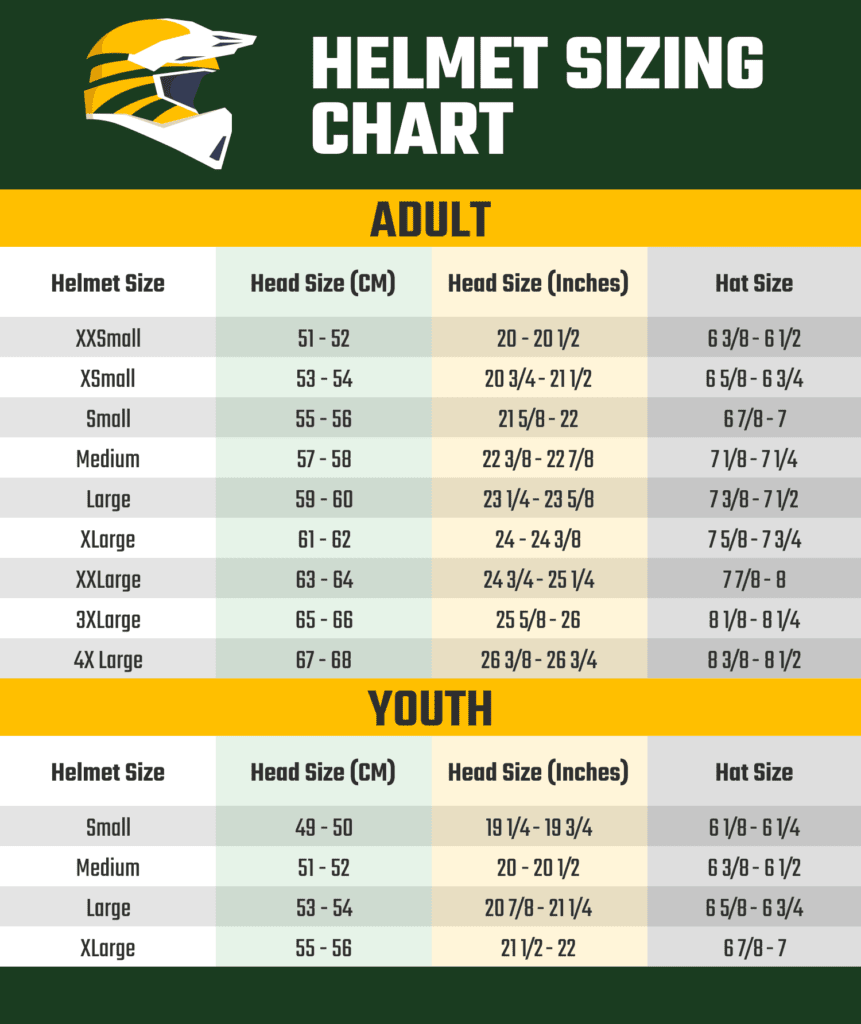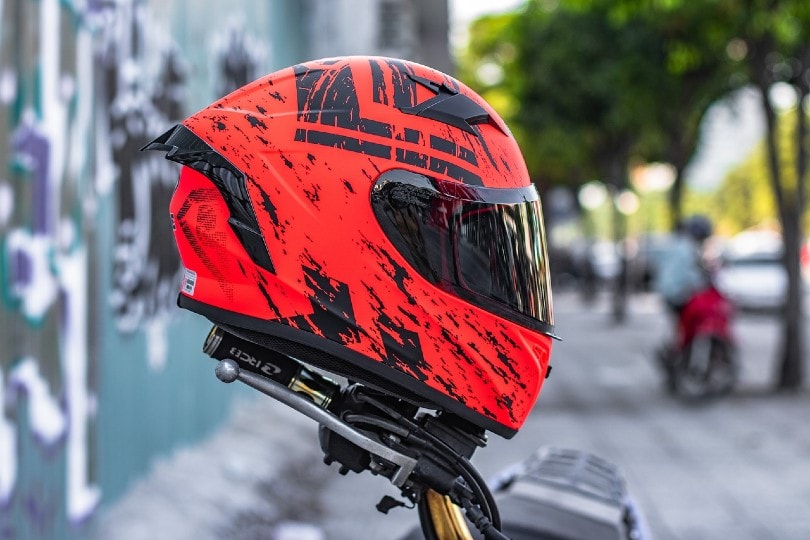Motorcycle Helmet Size Chart: How to Measure Your Head For The Right Fit
-

- Last updated:

Picking out your motorcycle helmet is one of the most impactful decisions you can make when you’re getting ready to hit the open road. A tight helmet can make life miserable as you’re cruising down the highway, and if you get in an accident, a poor fit can mean the difference between minor bumps and a life-altering head injury.
Getting the proper fit is crucial, but it takes more than finding the first one that matches your cap size. Several factors along with head size will determine the best motorcycle helmet. In this guide, we’ll show you how to research and test for the perfect helmet fit to ensure you stay safe and comfortable on the road.
Helmet Sizing Chart

How To Measure Your Head
Use a cloth tape measure to measure the circumference of your head. If you don’t have a tape measure, wrap a piece of string around your head, mark it, and measure the length.
Measure the circumference at the widest part of your head. For most people, that means positioning the tape about 2 cm above your eyebrows and 1 cm above your ears. Use a cm measurement to get the most accurate sizing.
Once you know your head circumference, you can use the above chart to find your helmet size. But before you buy the first helmet that matches your size, there are still a few considerations to ensure the most comfortable and safest fit.
Head Shape
Your head shape is a crucial consideration to ensure you get a snug, well-fitting helmet around your entire head. Along with their various sizes, manufacturers develop helmets to fit specific head shapes.
Head shape refers to how your head looks from a bird’s eye view.
- Long-oval: The head is longer from front to back (forehead to the back of the skull) than from ear to ear
- Intermediate-oval: The head is only slightly longer from front to back than from ear to ear
- Round-oval: The head is roughly the same length front to back as it is ear to ear
Intermediate-oval is the most common head shape. If the helmet doesn’t state the head shape, it is likely an intermediate-oval.
To determine your head shape, use a mirror to look at the top of your head or, better still, have a friend take a picture of your head. Pat your hair down so you get a more accurate idea of your skull shape.

Finding the Fit
A well-fitting helmet will be snug on your head and not allow any movement inside it. Over time, the helmet will loosen and break-in as it adapts to your head’s shape, so the ideal size may even feel tight the first time you wear it. It should not be painful. If you’re feeling too much pressure, try a size up.
Testing a Helmet’s Fit
Undo the chin strap and put the helmet on your head. It should be snug as you pull it down. If it slides on easily, try a smaller size.
Once the helmet is on, you should feel it snug against your entire crown. If you feel it snug on the sides of your head but not at the front or back, you need to change to a rounder shape. Likewise, if you feel pressure at the front and back but not at the ears, you’ll need to go with a longer oval shape.
Like the crown fit, the helmet’s cheek pads should be snug against your face, pushing your cheeks up slightly like a chipmunk. Test the fit by sliding a finger between your cheek and the cheek pad. It should feel tight between your face and the helmet interior. Don’t fret too much about the fit there, though, as most helmets will have interchangeable pads to size up or size down.
If the helmet feels good, try taking it off with the chinstrap in place. Grab the back of the helmet and try to pull it off. Do the same with the front of the helmet. If it comes off or has too much give, allowing the helmet to roll forward or backward, the helmet is too big.
Wear the helmet for 15–30 minutes to see how it feels as you move your head. It should always be snug, but it should never cause so much discomfort or pain that you want to take it off.
Turn and shake your head to see how the helmet moves with it. You can also grab the helmet and try moving it front to back and side to side to see how much it moves around your head. If the helmet allows your head to shift inside it, you need to step down a size.
Checking Visibility
Your eyes should sit at the center of the viewfinder, giving you the best frontal and peripheral vision. The upper edge of the port should be just above the eyebrows.

Adjusting the Fit
There are many ways to adjust inner padding around the cheeks and ears once you have found the right helmet. For that reason, you should focus primarily on the visibility and fit around the crown to ensure you have the proper size and shape. Then, size your cheek pads up or down if the helmet is causing pain or not pressing against your cheeks when you wear it.
The ear padding is a similar consideration. Your ears may fold when putting the helmet on, which is generally not an issue, but a change in padding could alleviate any discomfort. Keep any headphone or comm system in mind as well, as that will factor into the feel and function of any motorcycle helmet.
What Should I Do If My Head Is Between Sizes?
Sometimes, you may be unsure of the right size if two feel good. If that’s the case, go with the smaller one. If it isn’t causing pain around the crown or leaving red marks on your head when you take it off, you can usually make adjustments in the other padding areas to make it as comfortable as possible.
Final Thoughts
The right motorcycle helmet will elevate your ride and let you get the most out of the experience, filling you with comfort and confidence every time you hit the road. There are tons of options available in every shape and size, so you can be sure that the perfect model is out there for you. Take this sizing knowledge with you when you test out your next helmet, and you’ll find the best one to suit your needs and style in no time.
Featured Image Credit: Vander Films, Unsplash
Contents

